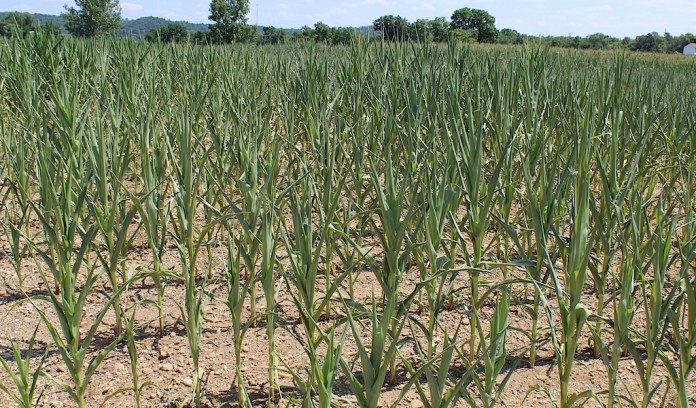So here we are in the middle of August, and the market is barely concerned that Ohio and Michigan crops are stressed for moisture. For the first time in several weeks the USDA corn condition ratings declined from the record levels we have been seeing, but the market shrugged off the decline.
Weekly ratings declined two percent to 74 percent good and excellent, but market analysts noted that decline was normal this time of year. Normal is not what Ohio and Michigan farmers are seeing, and that was reflected in the report.
Declining yields
In fact, those states were responsible for the average decline. Ohio was down a staggering seven percentage points to 47 percent good and excellent. Michigan was down four points to 54 percent. Those ratings would inspire higher prices if ratings decline were more general or if the weather looked worse.
In fact, weather forecasts are looking for more-than-normal rainfall in the next few days, even in the East. Locally we are expecting 90-degree temperatures for a few days, but if we get a little rain that is not necessarily bad.
Rain in Ashtabula County and Trumbull County has been spotty of late. This is what happens when we depend upon thunderstorms and get no general, all-day rains. Kinsman and Cortland have sometimes seen two inches of rain when other areas have only had a trace.
I asked Mike Badger in our Ashland office yesterday if his sadly dry area got any rain. His answer was, “Yes, a hundredth of an inch!”
Just sprinkles
Sounds like sprinkles on the windshield. For those local farmers looking at stressed corn, it is hard to absorb the remark I am reading in the CHS Hedging newsletter this morning.
Wrapping up corn is the remark: “A few eastern corn belt areas may still need some moisture, but overall corn potential is still looking very good.”
Corn prices have been steady for the last week. We put in the contract low on Aug. 2 at $3.29 December futures.
This Tuesday, Aug. 9, we are trading at $3.33-1/2, down one and a quarter. This means we are four and a half cents off the low, but also we have seen a $1.16-1/2 decline from the high in the middle of June.
Soybeans have seen prices supported by good export news. USDA says the crop is still unchanged from last week at 72 percent good and excellent. That would be negative for prices, since the market may have a little August fear of weather premium built in, but we are 22 percent ahead of last year for new crop export commitments.
Wheat news
Meanwhile, world wheat news has been mostly negative for prices. Most of the world’s major producers had great crops this year, and the resulting poor prices have been noted even by the major non-grain news outlets.
This morning, USA Today put out a story about how the large production world-wide was resulting in prices below the cost of production for the farmers. They cited yields of as much as 80-bushels per acre, but did not say where.
We had northeast Ohio producers with yields over 100 bpa this season. Just this morning I saw statistics that the Russian wheat crop would be 3.89 tons per hectare, up from $3.36 last year.
The exception to good yields has been France, where they have had record rains. Last year the French produced 40.6 million tons, but they are reduced to 29.5 million tons this year.
The crops here and worldwide have led to a general decline of prices on the December futures of $1.25. We had a high of $5.51-1/2 in early June, but a low of $4.26-1/2 last Tuesday, Aug. 2.
We had bounced over 12 cents recently, but are down four cents at $4.34 3/4 this morning. Seeing the story this morning reminded me of the rule of thumb traders always used regarding the Wall Street Journal.
It was always said that, once a big grain price trend was reported on the front page of that paper, the trend was over.
I hope that is true this morning. It would indicate a move back to higher prices!













